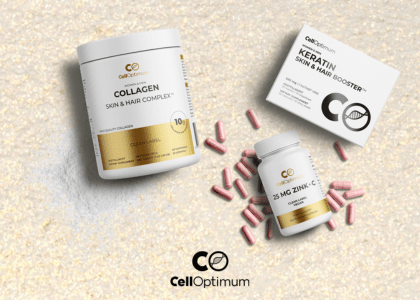Collagen, keratin & melanin - skin & hair

Collagen, keratin & melanin - skin & hair
The skin is the body's largest organ. Proper care and treatment is essential to maintaining the health and vitality of this important organ - your skin!
What does the skin consist of?
Skin is made up of several different parts, including water, protein, lipids (fats) and various minerals and other substances. Throughout your life, your skin will change, for better or worse. In fact, your skin regenerates approximately every 27 days. It is important to take proper care of your skin to maintain the health and vitality of this important organ.
What does the skin need every day?
Make sure you get a good skin care routine, drink plenty of water and cleanse your skin every day. Every day you should be sure to give your skin:
- Plenty of water.
- Thorough cleaning every day. In the evening, make sure you remove all your makeup and cleanse your skin properly before going to bed.
- Balanced nutrition.
- Moisture, moisture and moisture. This is a necessary step even for those with oily skin. There are plenty of moisturizing products on the market.
- Sun protection, sun protection and sun protection. It is imperative to protect your skin from harmful UVA and UVB rays. Sunscreen (SPF 30 or higher) is recommended every day. This will help prevent sun damage, skin cancer and wrinkles.
- You should get into the habit of keeping track of your skin, of your whole body. Familiarize yourself with your skin so that you notice any changes, such as birthmarks or blemishes that may need further attention.
What are the three layers of the skin?
Epidermis - the outermost layer of the skin
The epidermis is the thinnest layer, but it is responsible for protecting you from the harsh environment you are exposed to every day. The epidermis also hosts different types of cells:
- Keratinocytes, which produce the protein keratin, the main part of the epidermis.
- Melanocytes, which produce your skin pigment, called melanin.
- Langerhans cells, which prevent unwanted substances from entering the skin.
Dermis - the middle layer of the skin
The dermis is the layer that gives your skin its fullness. Aging and the sun can damage the dermis and lead to wrinkles. The dermis consists of a complex combination of blood vessels, hair follicles and glands. Here you'll find collagen and elastin, 2 proteins essential to skin health because they offer both support and elasticity (your skin's ability to return to its original state after being stretched). Fibroblasts are the cells you find in this layer, which synthesize (make) collagen and elastin. This layer also contains receptors for pain and touch.
Hypodermis - the fatty layer
The hypodermis hosts sweat glands as well as fat and collagen cells, and is responsible for preserving body heat and protecting your vital internal organs. Reduction of tissue in this layer contributes to "saggy" skin.
Which nutrients are important for the skin?
The collagen
Collagen is the most abundant protein in the skin and makes up about 70-80% of the skin. Collagen and elastin are responsible for keeping wrinkles and fine lines at bay. Unfortunately, over time, the environment and aging reduce your body's ability to produce collagen.
Collagen is usually not found in the traditional diet that we eat, as collagen occurs in the parts of the animal that we usually throw away. Therefore, it can be good to take extra collagen in the form of a dietary supplement in powder form every day - especially if you have passed the age of 25. However, you can help your own collagen production along the way by eating the right kind of food.
Of course, you can boost your body with collagen by eating a food supplement, which adds extra collagen to your body! Our product COLLAGEN - SKIN & HAIR COMPLEX™ contains natural marine collagen together with hyaluronic acid, vitamin C and silicon from bamboo, as well as important vitamins and minerals for the skin.
Keratin
Keratin is a protein that is abundant in the skin, hair, nails. Keratin is what gives skin its firmness/strength and helps build the protective barrier your skin offers. Keratin also contributes to the strong structure of the nails and hair.
Although keratin is not found in food, the right foods – which are rich in protein and certain vitamins – can increase keratin production and thus support skin, hair and nail growth.
Of course, you can boost your body with keratin by eating a food supplement, which adds extra keratin to your skin, your nails and your hair! Our product KERATIN - SKIN & HAIR BOOSTER™ contains natural keratin.
Melanin
Melanin is the pigment that gives skin, hair and eyes their color. Dark-skinned people have more melanin in their skin than light-skinned people. Melanin provides some protection against skin damage caused by the sun, in that the melanocytes increase their production of melanin in response to sun exposure.
If you want to get an extra boost of melanin to increase the hair's natural pigmentation, or counteract gray hair, you can try our ANTI-GRAY™ dietary supplement.
If you want to accelerate your tan and get a finer and deeper tan that looks natural, you can also eat the nutritional supplement ANTI-GRAY™ as it also affects your skin's pigment if you sunbathe!
Elastin
Think elastic. Elastin is found together with collagen in the dermis. Elastin is a protein responsible for giving structure to your skin and organs. As with collagen, elastin is affected by aging and environmental factors. Lower levels of this protein cause your skin to become wrinkled and saggy.
Have you ever wondered what freckles are and why only some have them? The answer lies in your genes.
Skin color is determined by the amount of melanin in the skin. The more melanin you have, the darker your skin will be. Sometimes melanin can be more concentrated in certain skin cells, resulting in freckles. This explains why freckles darken when exposed to the UV rays from the sun.
In the same way that you inherit your eye color and hair color, you can also inherit freckles. In fact, scientists have identified several genes known to cause freckles. One of the most well-known genes is called MC1R (the gene that controls how much melanin is created). Sometimes this gene is called the "red hair gene", which explains why red hair and freckles often go hand in hand.
Freckles contain more melanin than the rest of the skin…





